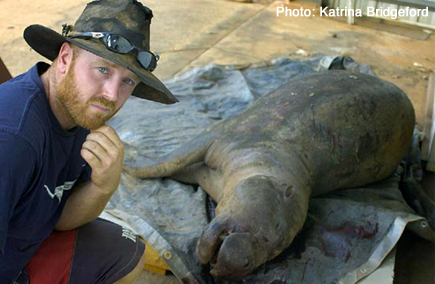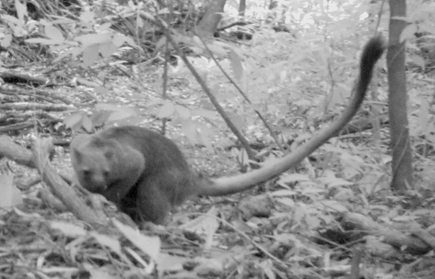Dave has the coolest job of anyone I know. A conservation biologist, he’s spent years at a time deep in the jungles of Cambodia and Vietnam counting and studying animals that are – by definition, being endangered – hard to find. He’s like a friendly Colonel Kurtz, and the only person I know who can pull off the ‘machete dangling from utility belt’ look. If that guy from Man Vs Wild and Dave were at the same party, the TV dude would blush and slink away…
Anway, hyperbole aside, Dave tends to meet some interesting people in his work. Apparently, in the deep outback in Australia there’s a low-flying helicopter pilot whose dream is to skewer a wild boar on his heli-skid, and has sharpened one up especially. Or there was the ex-US military bloke turned conservationist who was once tasked with choosing targets for possible nuclear attack in the Korean war: horrified, he selected spots as far from settlements as he could. And now this week Dave has been sent some cool images from people in the South Cape York area of Queensland, Australia.
The folks at the South Cape York Catchments project are working on a wildlife corridor project that would link a wet tropics world heritage area with an established national park. On the scale of worthwhile jobs, that kind of poops all over anything you or I might do. And part of their work is setting cameras triggered by motion detectors that record the area’s more secretive residents. Check out what turned up in their photos.
That looks a LOT like the end of lion. Ah! cryptozoology raises its shaggy, hard-to-identify head again!
I love this sort of thing. Everywhere in the world you find tales of mysterious beasts, animals that are supposed to be extinct but aren’t, and escaped critters roaming where they shouldn’t. There are the obvious ones like the Loch Ness monster, yeti and bigfoot, and then there are less-well known beasts like David Farrier’s Mongolian Death Worm, Puerto Rico’s blood-drinking Chupacabra (or ‘goat-sucker’), and our own local version – moose and huia living in Fiordland, moa on the West Coast, and a black panther roaming Mid-Canterbury.
The panther, for those who don’t read the Ashburton Guardian on a regular basis, is a large black cat that has been sighted many times since 2001 by some quite reputable drunks citizens – and was even investigated by Biosecurity NZ and staff at Orana Park zoo.
It’s real beast of the moors stuff. There’s kind of a whole category of cryptozoology that transports exotic animals into a domestic landscape – or rather, it doesn’t put them there – but our excitement at the combination ensures rumours spread. Funnily enough, Jason – the bloke who sent through the photo of our mystery tail – said there had also been rumours of big cats in their region for years. Locals believed they were escaped mascots from US bases at a place called Cooktown. And so the stories keep growing…
Psychologically, I think this is about a yearning to inject the domestic, known world with something wild and mysterious. It’s quite a Roman Catholic instinct, I think, to view the supposedly mundane through a story that transforms it into something wild and otherworldly. And what could be wilder than a big cat stalking through our comfortable lives? Just ask CS Lewis.
Mind you, not every yarn about exotic escapees is false. Check out the guy from the Northern Territories who thought he was shooting a wild pig, but instead killed a pygmy hippopotamus – an animal that belongs 16,000 kilometres away in the African nation of Liberia.
Poor guy – he looks remorseful (have you ever, by the way, seen anyone more Australian?), and you can understand the mistake – the thing looks a bit piggy. Someone probably even yelled “Hey look! A pyg…” – bang – “…my hippo. Damn.”
So anyway, what about the lion loose in Australia? That tail looks damned suggestive. Well, luckily a few days later the camera trap returned some images of its owner. Check him out – introducing the elusive bennett’s tree-kangaroo… a charming chap with an impressive tail.
Jason said no-one there seriously believed it might turn out to be a lion, though I must say I wasn’t so sceptical. And part of me is disappointed by the truth. But on the other hand, I think the mystery of animals like this is just as exciting as a lion in the meadow or a panther in Ashburton’s hills. You don’t need tall stories, or even religion, to make the world a more interesting place – the fascinating things are here already, under our noses – and as people like Dave and Jason and their conservation co-workers know already, they’re worth looking after.



